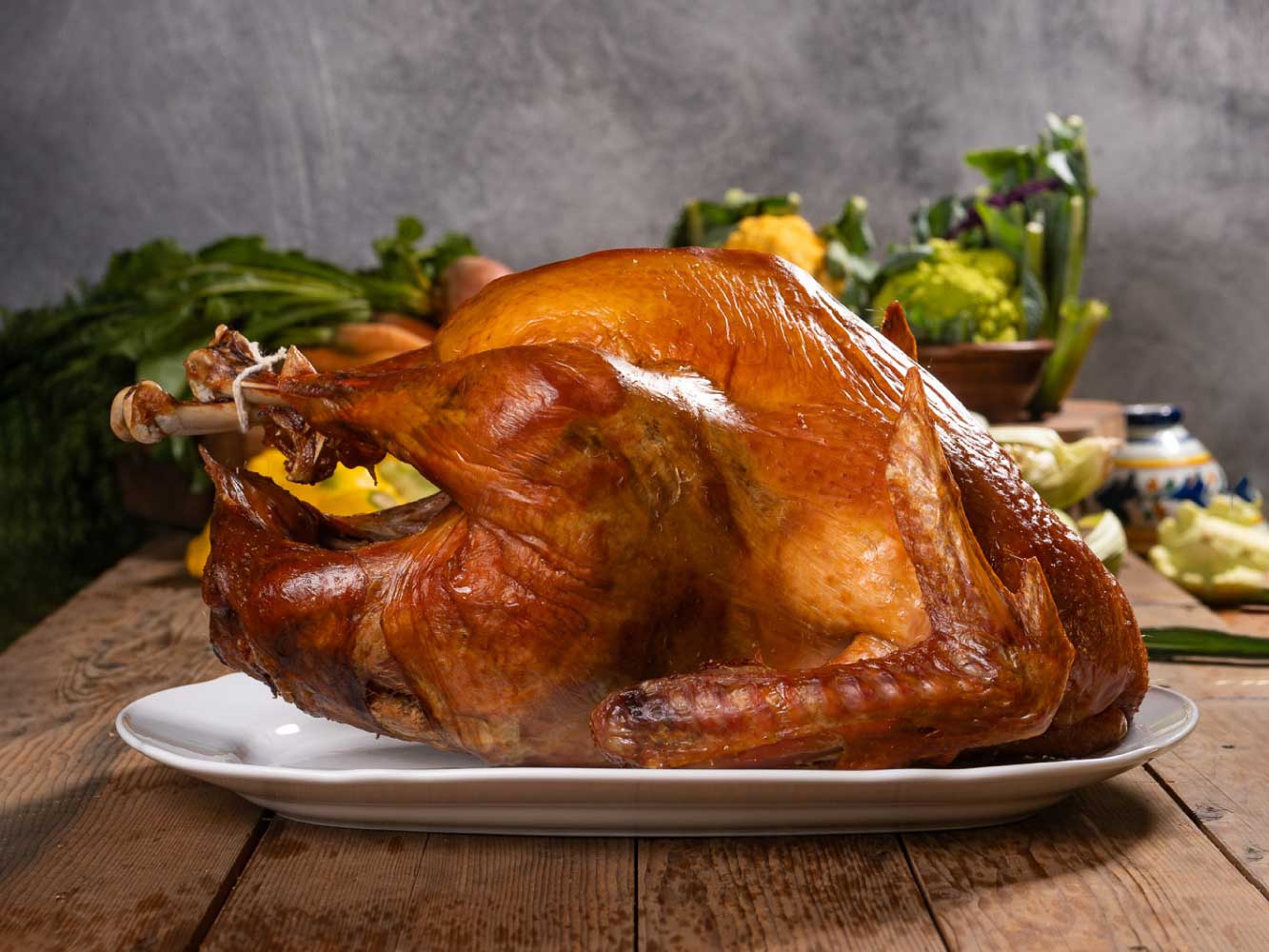
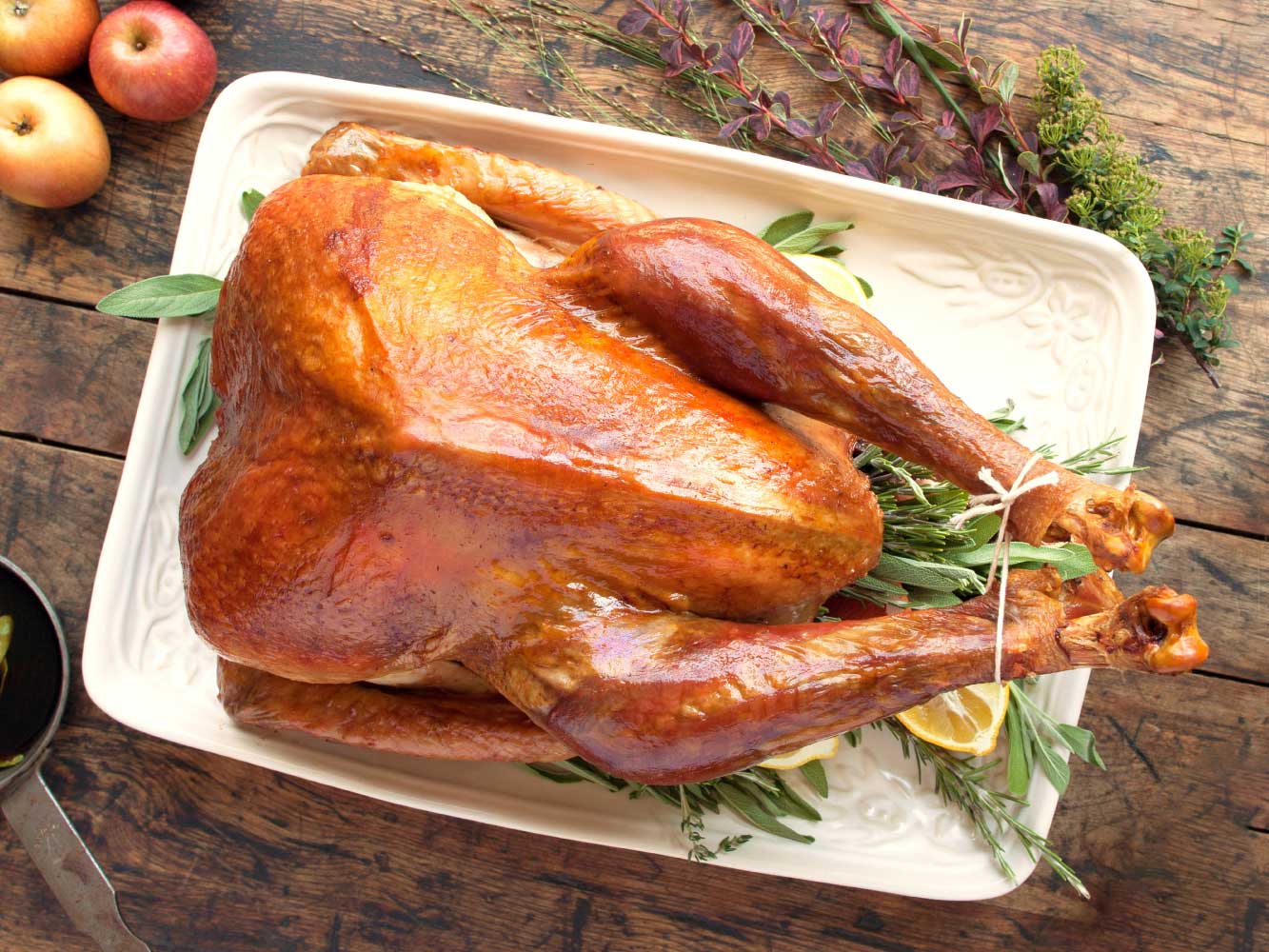
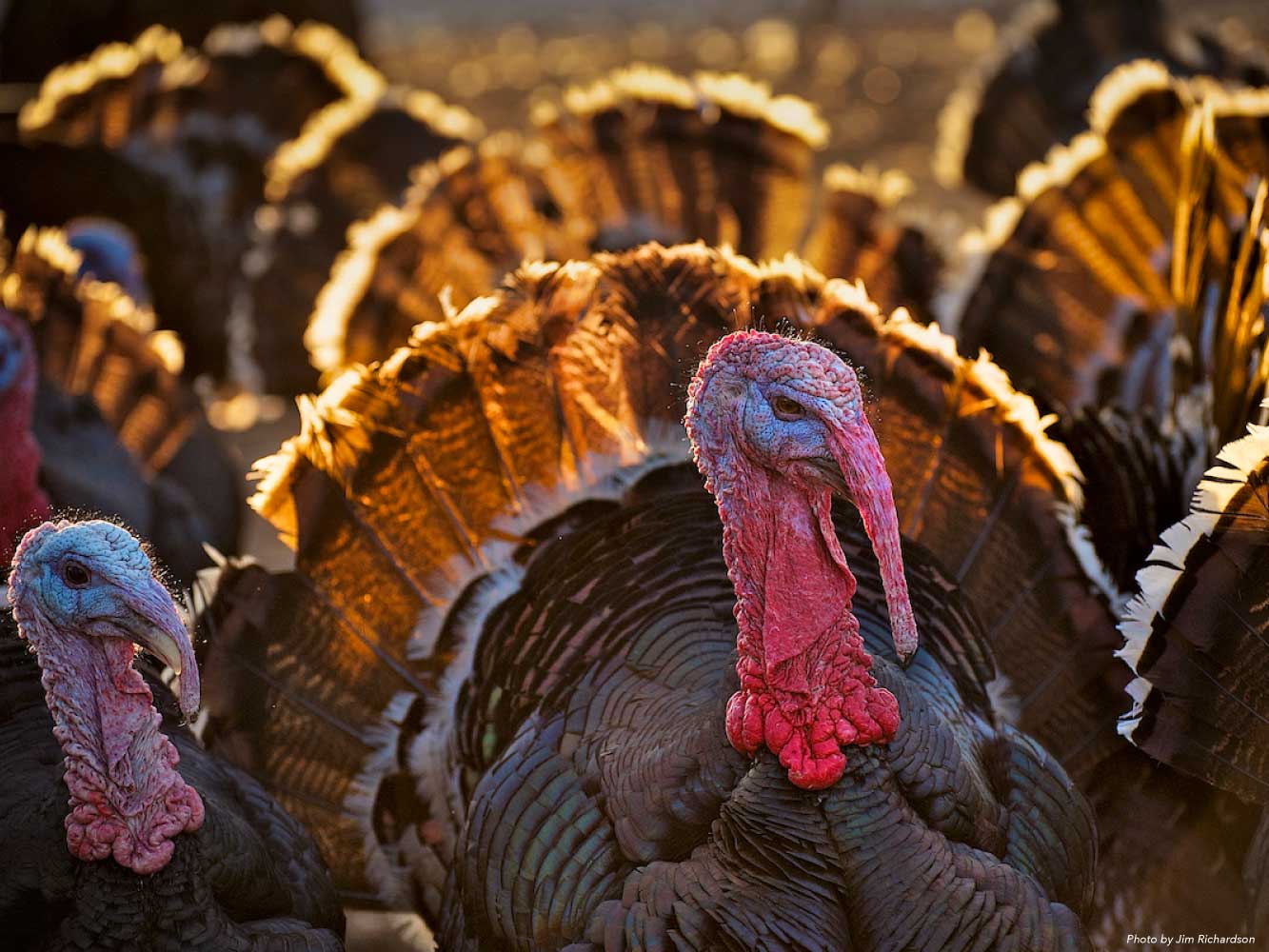
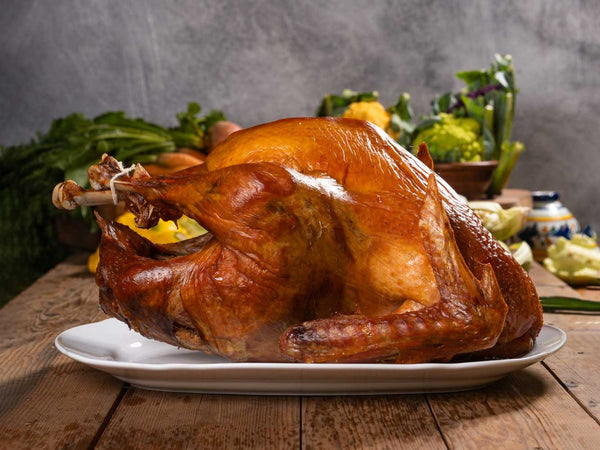
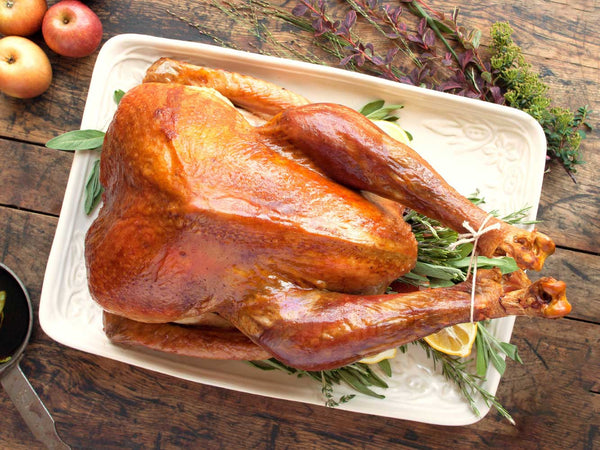
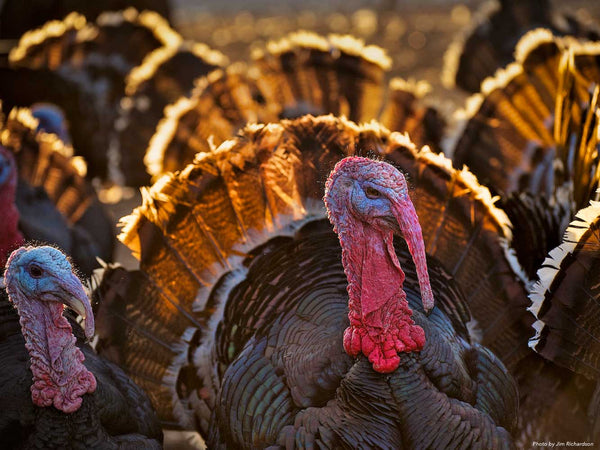



America's Oldest and Most Delicious Line of Turkey, 100% Pasture Raised and Antibiotic Free—Turkeys ship overnight for delivery on Tuesday, November 25th, 2025.
2025 Fresh Heritage Thanksgiving Turkey 14-16lb
One fresh, never frozen, turkey with neck and giblets
Turkeys ship overnight via FedEx for $45 each for delivery on Tuesday, November 25th, 2025.
For 24 Thanksgivings, we have committed ourselves to raising and distributing Frank Reese's entire turkey flock, the oldest continuous breeding lines left in the United States, with genetics traceable back to the 1830s when standards for a domesticated turkey were first written and agreed upon by poultry groups and the USDA. Frank's Good Shepherd Poultry Ranch in Kansas is the only remaining commercial Standardbred heritage poultry hatchery in the U.S. to meet these standards: Certified Standardbred, Pasture Raised, Free Ranging Flock, Vegetarian Fed, Naturally Mating, and Antibiotic Free from hatching to plate.
Heritage turkeys are the very foundation of our nation’s agricultural history and gastronomic identity. Each breed comes from a unique culinary tradition and genetic line, and boasts a different nuanced flavor. A true heritage breed is traceable to the pre-industrial farming era. Industrial breeds, the mainstay of the fast food and supermarket industries, were developed through years of genetic selection for non-gastronomic traits and artificial insemination. All our turkeys come from one of the eight varieties of Standardbred turkeys still in existence today: Bronze, Narragansett, Bourbon Red, White Holland, Black, Slate, Beltsville Small White, Royal Palm.
Through expanded infrastructure we are strengthening our rare breed poultry conservancy efforts. Birds descended from 19th and early 20th century flocks are extremely rare. Now, finally, we have created a second genetic center for America’s oldest breeds, an East Coast hatchery and farmer network overseen by Frank Reese himself. As a result these national treasures of gastronomy are more likely to endure.
As Frank turns 75, he has spent the past decade training a disciple, Jed Greenberg, to learn his skills as a Master Breeder of poultry. As always, Frank carefully selects all the breeders for hatching the following year, thus these culturally important genetic lines continue. Thank you for helping to save them by eating them.
This is the best tasting turkey you'll ever eat! Fans of Frank's turkeys include thousands of chefs like Alice Waters of Chez Panisse, who says, "Amazing! I have always focused on sustainability and I forgot all about BREED. What a difference in taste!"
Frequently Asked Questions:
We have a 100% customer satisfaction guarantee. If you are not satisfied, your money back!
Calculate about 1lb per person — all turkeys ship overnight via FedEx, and come with simple recipes and cooking instructions. All turkeys stay fresh until Thanksgiving. If being cooked after Thanksgiving, freeze upon receipt.
Please note, all other items in your order will be shipped immediately on the next available ship date, not with your turkey, unless you tell us otherwise in the Notes Section as you are checking out.
You will receive your FedEx tracking number when your turkey ships. Each turkey is shipped in its own box.
Turkeys are kept at a temperature of 33 degrees, which will keep them safe, not fully frozen.
All address changes and order cancellations must be received by Thursday, November 6th, 2025.
Unfortunately, we cannot fulfill breed requests.
Discount offers do not apply to heritage turkeys.
For any questions or concerns, call us at (718) 389-0985.
Good Shepherd Poultry Ranch is one of the most important farms in the world. Every morning at sunrise, for more than 50 years — in rain, snow, deep cold, and heat — Frank Reese opens the massive doors of the huge barns that house his few thousand birds, starting a trickle, then a wave, of chickens and turkeys who will free range the hundred-acre property for the day, before they are shepherded back indoors at night. These birds are truly free range and spend their time walking, picking the fields for food, naturally reproducing, and flying onto trees and fence tops. And they are truly from old stock — on this farm in Kansas live some of the last chickens and turkeys from a time before factory farming took over our food system. They are all endangered breeds.
Right before our eyes, dozens of our foundational poultry breeds are on the brink of extinction. These strains importance to America’s culture, food safety, and biodiversity is incalculable. Their loss would spell disaster for the future of the sustainable food system.
While most remain unaware of the looming extinction of Standardbred poultry breeds in the United States, there is a small community working to combat this crisis. One man on the plains of the Kansas prairie stands out as their greatest champion. Frank, in his seventies, is the sole remaining commercial breeder of Certified Standardbred poultry in the United States.
His Good Shepherd Poultry Ranch stands as the last remaining stronghold for many of America’s most important market breeds of chickens and turkeys with lineages dating back to the 19th and early 20th century including Plymouth Rock, New Hampshire, Rhode Island White, Cornish, Leghorn, Minorca, Bronze, Narragansett, White Holland, and Bourbon Red.
Having only one commercial farm left in the country to protect these natural treasures leaves them extremely vulnerable. In order to provide a safe future for these breeds, we must drastically increase their numbers. To address this issue, Frank Reese has started a nationwide conservation effort which will increase 10 breeds numbers to 100,000+ birds and spread them out over hundreds of farms throughout the United States. Heritage Foods together with the Good Shepherd Conservancy, a 501(c)(3) non-profit, are building a center to train farmers, to grow a larger hatchery to produce more birds, and to bring visitors from around the world to learn about this important issue.
The agri-tourism site being built on the farm will allow consumers, chefs, and farmers to visit for themselves the world site that is Good Shepherd Ranch. There is a collage of multicolored feathers on Frank's farm, from birds that each boast a unique history, taste, and flavor. The Bronze turkey for example shimmers with its coppery, bronze-colored metallic sheen and has origins in Rhode Island — it is the foundation for all domestic turkeys in the United States and the closest connection we have to the origin of the domesticated turkey.
The Barred Rock chicken, with its beautiful white and black barred feather pattern, is the foundation of the chicken industry and was raised by the millions from 1870 -1950. They remained king of the industry until they were replaced by the industrial Cornish. They say the original Barred Rock has never been beat in a tasting contest. As an animal it is hearty, tough, and reliable as well as lovely to look at.
It’s remarkable to think that almost every bird in the United States comes from the same genetic stock, derived from the same two or three industrial hatcheries producing unhealthy birds that cannot fly or survive in nature, and that have been built to die after only two or three years. The baby poults being supplied to farms large and small are a far cry from their healthy ancestors. They have not been genetically modified, like seed companies do, but they have been so overbred for certain traits like large breast size, fast growth, and small legs that they must be fed antibiotics and kept indoors to survive. The technology does not exist to freeze poultry sperm, so rare breeds must continue to reproduce their flocks on the farm, generation to generation, making Frank’s place in the world all the more important.
When Heritage Foods first started the only product we sold was heritage turkeys from Good Shepherd Poultry Ranch. We learned about them through the Slow Food Ark of Taste Project designed to save foods on the brink of extinction. The story of Frank was so compelling to us — his birds came to him from his mentor Norman Kardosh who inherited the birds from his Mother who had received heritage eggs by train from the Bird Brothers Hatchery in the 1860s. The birds Frank raises are essentially descended from stock that have only ever lived on the same two farms for more than 100 years! When we came to understand all these details, and that Frank was the last of his kind, just like so many of the birds on his farm — we had to do something!
Through sales direct to homes and to restaurant chefs, markets, and butchers we have managed to lay a stake in the ground claiming that we will not lose these birds to history and that fast food will not overtake our entire food supply! Thank you to all the buyers who have made this conservation effort a success story, all the while enjoying by far the tastiest birds on the market today!
Standard Bronze
The Bronze is the patriarch of all American turkey varieties in existence today. Carrying the genes of every other breed on our list, this bird holds the key to preserving the American Standardbred turkey. A great forager with a strong immune system and tolerant of extreme cold, quality, and resilience have helped the Standard Bronze stand the test of time.
Narragansett
This breed of turkey is likely the second oldest on our list. A natural mutation from the Bronze, it was developed by turkey farmers in the Narragansett region of Rhode Island in the 1800s. Beautiful silver and buff feathering, cold tolerance, and delicious flavor all make this historic bird very worthy of protection.
White Holland
The history of this noble breed stretches hundreds of years back, when it naturally mutated from the Bronze, much as the Narragansett did. Historically disfavored due to its white feathering, this attribute now makes it essential in the modern marketplace which favors white feathered birds. A healthy and robust bird with great potential and a storied past, we must conserve the White Holland to meet the needs of today’s picky consumers.
Bourbon Red
Developed in the early 1900s, this chestnut-red bird’s slow growth and slightly smaller stature make it more heat tolerant than the other turkeys on our list. Notably, the Bourbon Red was chosen by Marian Burros of the New York Times as the tastiest turkey in America, sparking a resurgence of interest in Standardbred turkeys throughout the United States.
Black
As explained by the Livestock Conservancy, "The Black turkey originated in Europe as a direct descendant of the Mexican turkeys carried home with explorers in the 1500s. Black-colored turkeys became popular in Spain where they were known as “Black Spanish,” and in England where they were known as “Norfolk Blacks.” After being selected for meat production for more than two centuries, the Black Spanish turkey made the voyage back to the Americas with early European colonists. Once here, the variety was crossed with Eastern wild turkeys, which formed the basis for the Black turkey variety in America. This Black variety was commercially viable through the early part of the 20th century. The Black turkey is in need of more stewards."
Royal Palm
The Royal Palm is a pretty but smaller turkey variety and this is one of the reasons it was phased out of the market. They are active, excellent foragers, and good flyers. As explained by the Livestock Conservancy, "The first birds in America to have the Palm color pattern appeared in a mixed flock of Black, Bronze, Narragansett, and Wild turkeys on the farm of Enoch Carson of Lake Worth, Florida in the 1920s and the Royal Palm was first recognized by the American Poultry Association in 1971. It’s similar to a European variety called the Pied, Crollwitz, or Black-laced White, which has been known since the 1700s."
Beltsville Small White
As described by the Livestock Conservancy, “The Beltsville Small White turkey was developed in the 1940s to fill a clearly identified consumer need — a bird that would fit in apartment-sized refrigerators and small ovens, and feed small families — but its success was short-lived and went nearly extinct by the 1970s. While considered a good bird for families, it was less embraced by the hotel and restaurant industry. Processors also preferred larger birds to obtain more “slices...” Despite this, the Beltsville Small White still had advantages. Beltsvilles had good reproductive qualities, including the ability to mate naturally, and could be selected, bred, and maintained by small-scale producers."
Slate
As explained by the Livestock Conservancy, "The Slate, or Blue Slate, variety is named for its color, which is solid to ashy blue over the entire body. The Slate was accepted by the American Poultry Association in 1874. It’s been popular in exhibition circles and is gaining popularity in pastured poultry production. Renewed interest in the biological fitness, survivability, and superior flavor of the Slate has captured consumer interest and created a growing market niche. The Slate is less well documented and more variable in type and color than any other variety. This makes it more challenging to breed consistently than the others."
How to Prepare
All heritage turkeys arrive with detailed cooking instructions including pro tips, recipes, and cooking guidelines. We also operate a 24 hour Turkey Hotline on Thanksgiving Day for last minute questions.
Heritage turkeys are very easy to prepare as their inherent flavor is so spectacular. We recommend:
1. Take the bird out of the refrigerator an hour prior to cooking.
2. Rub with olive oil or butter, season with salt, pepper, and your favorite herbs like rosemary and thyme. Roast in the middle of a 325°F oven.
3. Cook to an internal temperature of 165°F, remembering that the temperature will continue to rise after leaving the oven.
Calculate around 8-12 minutes per pound depending on the size of the bird in a 325°F oven. Smaller birds (up to 14 lb) typically need 8-10 minutes per pound. Larger birds may need 10-12 minutes per pound. Ovens differ, so check the internal temperature often.
© 2025, Heritage Foods Powered by Shopify
